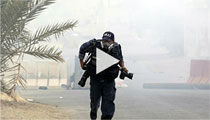Journalists struggled to carry out their work freely as the space for independent reporting diminished in Sudan. Khartoum intensified its crackdown against journalists with a record number of detentions, newspaper confiscations, and closures, leading to significant financial losses for many newspapers and layoffs among journalists. In June, protests against austerity measures and rising fuel prices quickly evolved into anti-government demonstrations. As journalists attempted to cover these historic events, the National Intelligence Security Services warned journalists not to cover the protests, detained several foreign and local journalists who did, confiscated newspapers that dared to mention the demonstrations, and blocked three critical websites. By August, the government had quashed the protest movement. The authorities continued to suppress coverage of Sudan’s conflict with South Sudan, which gained independence in 2011, and kept a particularly tight lid on information involving the fighting in oil-rich South Kordofan.
Sudan
» Press freedom deteriorates with intensified campaign to silence critical press.
» Authorities crack down on journalists covering anti-government protests.
Journalists struggled to carry out their work freely as the space for independent reporting diminished in Sudan. Khartoum intensified its crackdown against journalists with a record number of detentions, newspaper confiscations, and closures, leading to significant financial losses for many newspapers and layoffs among journalists. In June, protests against austerity measures and rising fuel prices quickly evolved into anti-government demonstrations. As journalists attempted to cover these historic events, the National Intelligence Security Services warned journalists not to cover the protests, detained several foreign and local journalists who did, confiscated newspapers that dared to mention the demonstrations, and blocked three critical websites. By August, the government had quashed the protest movement. The authorities continued to suppress coverage of Sudan’s conflict with South Sudan, which gained independence in 2011, and kept a particularly tight lid on information involving the fighting in oil-rich South Kordofan.
-
27
Attacks in one-month period -
0
Imprisoned on December 1 -
30
Newspaper confiscations -
$5,000
Losses per confiscation
Between June 19 and July 20, during the height of anti-government protests, the authorities took severe measures to silence coverage, including arrests, newspaper confiscations, and the blocking of critical websites, CPJ research shows.
| 13 | Journalists detained |
| 3 | Websites blocked |
| 3 | Newspaper editions confiscated |
| 2 | Journalists deported |
| 2 | Homes raided |
| 2 | Computers seized |
| 1 | Newspaper suspended |
| 1 | Office raided |
Although no journalists were imprisoned on December 1, when CPJ conducted its annual census, Sudan detained at least 11 journalists over the course of the year, CPJ research shows.
CPJ documented the confiscation of at least 30 newspaper issues in the first half of 2012, compared with 19 such confiscations in all of 2011. Some independent and pro-opposition newspapers were targeted repeatedly. In the past, the NISS would censor publications in advance by dispatching agents to newsrooms. But in 2012, with an apparent goal of inflicting heavy financial losses, the authorities censored newspapers after they had been printed, CPJ research shows.
12
Editions of Al-Midan seized6
Editions of Al-Jarida seized4
Editions of Al-Tayar seizedBy confiscating newspaper editions, the NISS aimed to cause financial losses at critical newspapers, Sudan's main media source. Every confiscated edition resulted in losses up to 15,000 Sudanese pounds (US$5,000), CPJ research shows.

